Items
In item set
MacKay Letters
-
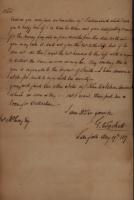 MacKay_Letter_063 Letter from G. V. Tackett to John McKay asking him to collect delinquent payment form Bastian Smith. If Smith does not cooperate he is to give the papers to the Sheriff. Tackett tells McKay other papers for John D. Nelson will be sent soon. August 19, 1817. Transcription: D[ea]r Sir Enclosed you will find an execution ag’t [against] Bastian Smith which I wish you to notify him & in case he comes and gives satisfactory sureity for the money payable in four months from this date with int [interest] you may take it and not give the Ex’n [execution] to the Shff [Sheriff] but if he does not do this I want the Ex’n handed to the Shff with a request to collect the [?] as soon as may be - My sending this to you is agreeable to the request of Smith - I have drawn a note for Smith to sign with his sureity - You will find the other Notes ag’t John D. Nelson enclosed as soon as they are out I want them put in a train for collection - I am D[ea]r Sir yours tr [signed] G. V. Tackett Sen. [Seneca] Falls Aug 19th 1817 Jno MCay Esq
MacKay_Letter_063 Letter from G. V. Tackett to John McKay asking him to collect delinquent payment form Bastian Smith. If Smith does not cooperate he is to give the papers to the Sheriff. Tackett tells McKay other papers for John D. Nelson will be sent soon. August 19, 1817. Transcription: D[ea]r Sir Enclosed you will find an execution ag’t [against] Bastian Smith which I wish you to notify him & in case he comes and gives satisfactory sureity for the money payable in four months from this date with int [interest] you may take it and not give the Ex’n [execution] to the Shff [Sheriff] but if he does not do this I want the Ex’n handed to the Shff with a request to collect the [?] as soon as may be - My sending this to you is agreeable to the request of Smith - I have drawn a note for Smith to sign with his sureity - You will find the other Notes ag’t John D. Nelson enclosed as soon as they are out I want them put in a train for collection - I am D[ea]r Sir yours tr [signed] G. V. Tackett Sen. [Seneca] Falls Aug 19th 1817 Jno MCay Esq -
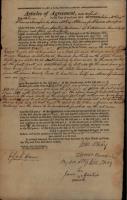 MacKay_Letter_037 Agreement of the deed of the sale of land in Evon [Avon] Caledonia, New York, by John Mckay and Thomas Mumford to Jane Martin. June 1, 1816. Transcription of print and handwriting: [front] Articles of Agreement, made this first Day of June in the Year of our Lord 1816 Between John McKay & Thomas Mumford by John McKay Attorney for Thomas Mumford of the first part, and Jane Martin (widdow) of Caledonia County of Genesee and State of New York of the second part, as follows, to wit:--- The said parties of the first part, here-by covenant and agree with the said party of the second part, that they will sell and convey in fee, by a good and sufficient Deed, containing a full covenant of warranty, to the said party of the second part, all that certain piece or parcel of Land, situate, lying, and being in the Town of Caledonia in the County of Genesee and state of New-York and in the Village of Evon [Avon] known and distinguished on a map of said village made by Orange Risdon as Lot No. 45 bounded southerly on the state Road Westerly on Lot No 44 Northeasterly by Land owned by the said parties of the first part and southeasterly by Lot No. 46 the said piece of land being four Rods wide on the State Road and running back from the same twenty Rods to contain half an acre of Land and no more Upon the payment by the said party of the second part, to the said parties of the first part, of the Sum of $34.00 the first day of June 1817 and the sum of $33.00 first day of June 181 and the like sum of $33.00 the first day of June 1819 with interest on each of the above sums to be paid annually provided the said party of the second part & all within one year from the date hereof erect a dwelling house on the said Lot No. 45 one and a half stories high and at least equal to 14 feet by 20 either a frame or brick building and the same to be handsomely finished on the outside And the said party of the second part, covenants and agrees with the said parties of the first part, to pay them the said sums of money in a manner aforesaid, with the interest as aforesaid, which payment is hereby declared to be a condition precedent to the execution of a Deed by the said parties of the first part; and in case of failure on the part of the said party of the second part, to fulfill this contract, she the said party of the second part, hereby covenant and agree to pay to the said parties of the first part, the sum of twenty dollars which is agreed to be the liquidated damages for such failure, and on the payment of the said sum of twenty dollars this contract is to be void. In witness whereof, the said parties have hereunto set their Hands and Seals, the Day and Year first above written. Sealed and delivered in the presence of} [signed] John McKay [signed] Thomas Mumford by his Atty John McKay Jane Martin Her mark [signed] Elijah Owen
MacKay_Letter_037 Agreement of the deed of the sale of land in Evon [Avon] Caledonia, New York, by John Mckay and Thomas Mumford to Jane Martin. June 1, 1816. Transcription of print and handwriting: [front] Articles of Agreement, made this first Day of June in the Year of our Lord 1816 Between John McKay & Thomas Mumford by John McKay Attorney for Thomas Mumford of the first part, and Jane Martin (widdow) of Caledonia County of Genesee and State of New York of the second part, as follows, to wit:--- The said parties of the first part, here-by covenant and agree with the said party of the second part, that they will sell and convey in fee, by a good and sufficient Deed, containing a full covenant of warranty, to the said party of the second part, all that certain piece or parcel of Land, situate, lying, and being in the Town of Caledonia in the County of Genesee and state of New-York and in the Village of Evon [Avon] known and distinguished on a map of said village made by Orange Risdon as Lot No. 45 bounded southerly on the state Road Westerly on Lot No 44 Northeasterly by Land owned by the said parties of the first part and southeasterly by Lot No. 46 the said piece of land being four Rods wide on the State Road and running back from the same twenty Rods to contain half an acre of Land and no more Upon the payment by the said party of the second part, to the said parties of the first part, of the Sum of $34.00 the first day of June 1817 and the sum of $33.00 first day of June 181 and the like sum of $33.00 the first day of June 1819 with interest on each of the above sums to be paid annually provided the said party of the second part & all within one year from the date hereof erect a dwelling house on the said Lot No. 45 one and a half stories high and at least equal to 14 feet by 20 either a frame or brick building and the same to be handsomely finished on the outside And the said party of the second part, covenants and agrees with the said parties of the first part, to pay them the said sums of money in a manner aforesaid, with the interest as aforesaid, which payment is hereby declared to be a condition precedent to the execution of a Deed by the said parties of the first part; and in case of failure on the part of the said party of the second part, to fulfill this contract, she the said party of the second part, hereby covenant and agree to pay to the said parties of the first part, the sum of twenty dollars which is agreed to be the liquidated damages for such failure, and on the payment of the said sum of twenty dollars this contract is to be void. In witness whereof, the said parties have hereunto set their Hands and Seals, the Day and Year first above written. Sealed and delivered in the presence of} [signed] John McKay [signed] Thomas Mumford by his Atty John McKay Jane Martin Her mark [signed] Elijah Owen -
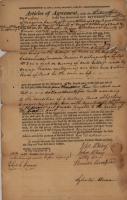 MacKay_Letter_036 Agreement of the deed of the sale of land in Evon [Avon], Caledonia, New York, by John Mckay and Thomas Mumford to Sylvester Brown. May 13, 1816. Transcription of print and handwriting: Articles of Agreement, made this thirteenth Day of May in the Year of our Lord 1816 Between John McKay of Caledonia County of Genesee & State of N York and Thomas Mumford of Cayuga County of Cayuga & State of N York by John McKay his attorney of the first part, and Sylvester Brown of Caledonia County of Genesee & State aforesaid of the second part, as follows, to wit:--- The said parties of the first part, here-by covenant and agree with the said party of the second part, that they will sell and convey in fee, by a good and sufficient Deed, containing a full covenant of warranty, to the said party of the second part, all that certain piece or parcel of Land, situate, lying, and being in the Town of Caledonia in the County of Genesee and State of New-York situate lying and being in the Village of Evon [Avon] in the town of Caledonia aforesaid, known & distinguished by Lot No 3 on a map or survey of said village made by Orange Risdon containing one acre and sixteen Rods of Land be the same or less upon the payment by the said party of the second part, to the first parties of the first part, of the Sum of one thousand three hundred and two dollars & seventy five cents according to the condition of a certain Bons obligatory bearing even date here with executed by the party of the first part & made payable to the parties of the first part And the said party of the second part, covenant and agree with the said parties of the first part, to pay them the said sum of money in a manner aforesaid, with the interest as aforesaid, which payment is hereby declared to be a condition precedent to the execution of a Deed by the said parties of the first part; and in case of failure on the part of the said party of the second part, to fulfill this contract, he the said party of the second part, hereby covenant and agree to pay to the said parties of the first part, the sum of ten dollars which is agreed to be the liquidated damages for such failure, and on the payment of the said sum of ten dollars this contract is to be void. In witness whereof, the said parties have hereunto set their Hands and Seals, the Day and Year first above written. Sealed and delivered in the presence of} [signed] John McKay [signed] John McKay attorney for Thomas Mumford [signed] Sylvester Brown N.B. all insurers and interlinings made before signing [signed] Elijah Owen
MacKay_Letter_036 Agreement of the deed of the sale of land in Evon [Avon], Caledonia, New York, by John Mckay and Thomas Mumford to Sylvester Brown. May 13, 1816. Transcription of print and handwriting: Articles of Agreement, made this thirteenth Day of May in the Year of our Lord 1816 Between John McKay of Caledonia County of Genesee & State of N York and Thomas Mumford of Cayuga County of Cayuga & State of N York by John McKay his attorney of the first part, and Sylvester Brown of Caledonia County of Genesee & State aforesaid of the second part, as follows, to wit:--- The said parties of the first part, here-by covenant and agree with the said party of the second part, that they will sell and convey in fee, by a good and sufficient Deed, containing a full covenant of warranty, to the said party of the second part, all that certain piece or parcel of Land, situate, lying, and being in the Town of Caledonia in the County of Genesee and State of New-York situate lying and being in the Village of Evon [Avon] in the town of Caledonia aforesaid, known & distinguished by Lot No 3 on a map or survey of said village made by Orange Risdon containing one acre and sixteen Rods of Land be the same or less upon the payment by the said party of the second part, to the first parties of the first part, of the Sum of one thousand three hundred and two dollars & seventy five cents according to the condition of a certain Bons obligatory bearing even date here with executed by the party of the first part & made payable to the parties of the first part And the said party of the second part, covenant and agree with the said parties of the first part, to pay them the said sum of money in a manner aforesaid, with the interest as aforesaid, which payment is hereby declared to be a condition precedent to the execution of a Deed by the said parties of the first part; and in case of failure on the part of the said party of the second part, to fulfill this contract, he the said party of the second part, hereby covenant and agree to pay to the said parties of the first part, the sum of ten dollars which is agreed to be the liquidated damages for such failure, and on the payment of the said sum of ten dollars this contract is to be void. In witness whereof, the said parties have hereunto set their Hands and Seals, the Day and Year first above written. Sealed and delivered in the presence of} [signed] John McKay [signed] John McKay attorney for Thomas Mumford [signed] Sylvester Brown N.B. all insurers and interlinings made before signing [signed] Elijah Owen -
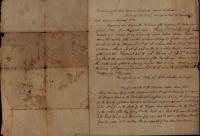 MacKay_Letter_033 Survey of a lot of land owned by Alex McDonald in Ontario County, NY. No date. Dates reflected in letter refer to previous surveys. Transcription: The survey of the State Road in Caledonia cannot be found Survey of Lot No. 27, conveyed to Alex McDonald by deed dated 12 January 1803 - Beginning at a post in the N bounds of the Highway 85 links East of post No. 22 - 26 on the South side - Thence S 87°40’ E 10 chs to the middle of a small spring - Thence down the middle of the outlet of said spring as follows viz N 2°30’ E 1 ch 27 links thence S 87°3o’ E 1 chain thence N. 27° E 1ch 50 links - thence N. 48° E 3 ch 50 lks to a white maple westside of the out let - Thence N. 42° W 1 ch Thence N. 87 1/2° W 4 ch 37 lks to the most Easterly extremity of the Big Spring - thence round the south side of said spring so far that a line drawn from the place of beginning at said N 2° 30’ E will intersect the same containing 5 62/100 acres - The above is a copy of John Smiths survey - Copy of a deed to A. McDonald dated 1 June 1805 being 1 acre lying in the East part of lot N 49 Northwardly of & adjoining the Magara Road in the Township of Springfield (or No 1 in the first range) in the County of Ontario aforesaid and bounded as follows to to wit - on the East ny Lot No. 27 - on the South by the Niagara Road aforesaid - on the North by the waters of the Big Spring to the West by a line to be run parallel to the East line of said lot number forty nine and at such a distance West from the same as to contain the said quantity of one acre & no more [inside cover] Written in pencil: Description of McDonald lot Written in ink: M: John McKay Caledonia Monroe County
MacKay_Letter_033 Survey of a lot of land owned by Alex McDonald in Ontario County, NY. No date. Dates reflected in letter refer to previous surveys. Transcription: The survey of the State Road in Caledonia cannot be found Survey of Lot No. 27, conveyed to Alex McDonald by deed dated 12 January 1803 - Beginning at a post in the N bounds of the Highway 85 links East of post No. 22 - 26 on the South side - Thence S 87°40’ E 10 chs to the middle of a small spring - Thence down the middle of the outlet of said spring as follows viz N 2°30’ E 1 ch 27 links thence S 87°3o’ E 1 chain thence N. 27° E 1ch 50 links - thence N. 48° E 3 ch 50 lks to a white maple westside of the out let - Thence N. 42° W 1 ch Thence N. 87 1/2° W 4 ch 37 lks to the most Easterly extremity of the Big Spring - thence round the south side of said spring so far that a line drawn from the place of beginning at said N 2° 30’ E will intersect the same containing 5 62/100 acres - The above is a copy of John Smiths survey - Copy of a deed to A. McDonald dated 1 June 1805 being 1 acre lying in the East part of lot N 49 Northwardly of & adjoining the Magara Road in the Township of Springfield (or No 1 in the first range) in the County of Ontario aforesaid and bounded as follows to to wit - on the East ny Lot No. 27 - on the South by the Niagara Road aforesaid - on the North by the waters of the Big Spring to the West by a line to be run parallel to the East line of said lot number forty nine and at such a distance West from the same as to contain the said quantity of one acre & no more [inside cover] Written in pencil: Description of McDonald lot Written in ink: M: John McKay Caledonia Monroe County -
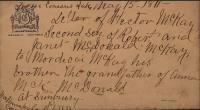 MacKay_Letter_025 Letter from Hector McKay in Conesus Lake, New York to his brother Mordecai McKay in Pennsylvania. He describes how and what the family is doing. May 15 1811. Letter is blurred in spots and difficult to read. Transcription: [front] Mr Mordecai McKay Sunbury North County [back] D[ea]r Brother its long time sense I have taken my pen to [?] a word or two to you haveing so good an opportunity that mother is well at my house Also our Brothers and Sisters are all well Sister Jane hath one son and calls him Mordecai McKay Whaley John hath two sons Robert two daughters Daniel two daughters and poor me one Daughter & two sons - Brother Robt started last Satderday to montreall withe larg cargo of flower [?] he keeps very large assortment goods for sale at the Big Spring Mother his feble But she can ride twelve mils [miles] in a day yet but that be making but [?] [?] to get to Sunbury to see you and yours but she expect god willing to [?] all her chilldren and grand chilldren in this Counry this summer she cannot think of going Pennsylvania in her life time Hugh Harrison Esq. departed this life by a stroke he got at Bosleys saw mill Brother Daniel hath been preparing lumber to go down the Ohio River with but watters keeps still so that I dont expect he will get down this season - I must think you have for got me alltogether Mr. Brewer and family arrived here last friday in good order [envelope] From Conesus Lake May 15 1811 Written on the envelope at a later time: Letter of Hector McKay Second Son of Robert and Jenet McDonald McKay. To Mordecai McKay his brother - the grandfather of Anna McK McDonald at Sunbury Northumberland Co. Penn
MacKay_Letter_025 Letter from Hector McKay in Conesus Lake, New York to his brother Mordecai McKay in Pennsylvania. He describes how and what the family is doing. May 15 1811. Letter is blurred in spots and difficult to read. Transcription: [front] Mr Mordecai McKay Sunbury North County [back] D[ea]r Brother its long time sense I have taken my pen to [?] a word or two to you haveing so good an opportunity that mother is well at my house Also our Brothers and Sisters are all well Sister Jane hath one son and calls him Mordecai McKay Whaley John hath two sons Robert two daughters Daniel two daughters and poor me one Daughter & two sons - Brother Robt started last Satderday to montreall withe larg cargo of flower [?] he keeps very large assortment goods for sale at the Big Spring Mother his feble But she can ride twelve mils [miles] in a day yet but that be making but [?] [?] to get to Sunbury to see you and yours but she expect god willing to [?] all her chilldren and grand chilldren in this Counry this summer she cannot think of going Pennsylvania in her life time Hugh Harrison Esq. departed this life by a stroke he got at Bosleys saw mill Brother Daniel hath been preparing lumber to go down the Ohio River with but watters keeps still so that I dont expect he will get down this season - I must think you have for got me alltogether Mr. Brewer and family arrived here last friday in good order [envelope] From Conesus Lake May 15 1811 Written on the envelope at a later time: Letter of Hector McKay Second Son of Robert and Jenet McDonald McKay. To Mordecai McKay his brother - the grandfather of Anna McK McDonald at Sunbury Northumberland Co. Penn -
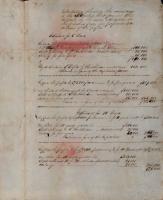 MacKay_Letter_111 A report to stockholders showing the possible capital that might be brought in from a Flour Mill with 5 and 10 year calculations as well as variances that may occur and how it would affect the capital. It also has the rules set down by the board. It does not appear to be a complete document. No date. Transcription: [front] Amount of Capital} Estimated for the building of the mill and its appurtenances $65.000. Sum to be invested in grain $10.000. Total amount of the Capital to be paid in $75.000. Should it be the choice of the members that shall constitute the association to increase this amount the undersigned would say that $80.000 might be used to advantage. Stock} The undersigned would propose that the shares be $500. Each. and that for the $75.000. capital paid in, there shall be issued stock for the amount of $112.500., and that $37.500 of this stock (or seventy five shares) shall be the sole and exclusive property of the undersigned Joslyn Hutchinson, in consideration of his taking upon himself the whole responsibility of erecting the mill upon the best known models and when said mill is finished, to become the active director of all business connected therewith, in purchasing, employing requisite labor, manufacturing, selling, accounting and declaring and paying over the dividends. Directorship} As the Director and Superintendent of said Flouring Mill, the said Joslyn Hutchinson proposed to hold himself at all times strictly accountable to the Shareholders or board of officers for the faithful discharge of his duties; that he is to be advised by them whenever they may think proper to do so, and to submit all records and papers to them and to give any desired information at any time it is requested;-- and that the said Hutchinson shall receive in addition to the amount of Stock above mentioned the sum of three thousand dollars per annum, to defray all contingent personal expenses connected with the superintendence. [back] Calculations showing the advantages to the stock members that pay in the capital, by the mode indicated in the preceding page, in preference to a division of the profits. Estimate for 5 years Suppose the profits amount to only $60.000 per annum one third ⅓ of that for five years would be —-----------------$100.000 Stock delivered to J. Hutchinson (actual value)-----------$25.000 Salary for five years—-----------------------------------------$15.000 —----------------------------------------------------------------$140.000 By a division of Profits J. Hutchinson would have 150.000 Balance in favor of the capitalists $10.000 /////////////////////////////////////////////////////////////////////////////////////////// Suppose the profits be $75.000 per annum, ½ for five years is—-----------$187.500 One third of that amount for 5 years would be —--------$125.000 Stock delivered to J. Hutchinson (actual value)------------$25.000 Salary for five years—------------------------------------------$15.000 —-----------------------------------------------------------------$165.000 Balance in favor of the capitalists—-------------------------$22.500 /////////////////////////////////////////////////////////////////////////////////////////// Estimate for 10 years Suppose the profits be $60.000 per annum, ½ for 10 years would be —-----------$300.000 One third of that amount for 10 years would be —------$200.000 Stock delivered to J. Hutchinson (actual value)-----------$25.000 Salary for five years—------------------------------------------$30.000 —-----------------------------------------------------------------$255.000 Balance in favor of the capitalists—-------------------------$45.000 /////////////////////////////////////////////////////////////////////////////////////////// Suppose the profits be $75.000 per annum, ½ for 10 years would be—-----------$275.000 One third of that amount for 10 years would be —------$250.000 Stock delivered to J. Hutchinson (actual value)------------$25.000 Salary for five years—------------------------------------------$30.000 —-----------------------------------------------------------------$305.000 Balance in favor of the capitalists—-------------------------$70.000
MacKay_Letter_111 A report to stockholders showing the possible capital that might be brought in from a Flour Mill with 5 and 10 year calculations as well as variances that may occur and how it would affect the capital. It also has the rules set down by the board. It does not appear to be a complete document. No date. Transcription: [front] Amount of Capital} Estimated for the building of the mill and its appurtenances $65.000. Sum to be invested in grain $10.000. Total amount of the Capital to be paid in $75.000. Should it be the choice of the members that shall constitute the association to increase this amount the undersigned would say that $80.000 might be used to advantage. Stock} The undersigned would propose that the shares be $500. Each. and that for the $75.000. capital paid in, there shall be issued stock for the amount of $112.500., and that $37.500 of this stock (or seventy five shares) shall be the sole and exclusive property of the undersigned Joslyn Hutchinson, in consideration of his taking upon himself the whole responsibility of erecting the mill upon the best known models and when said mill is finished, to become the active director of all business connected therewith, in purchasing, employing requisite labor, manufacturing, selling, accounting and declaring and paying over the dividends. Directorship} As the Director and Superintendent of said Flouring Mill, the said Joslyn Hutchinson proposed to hold himself at all times strictly accountable to the Shareholders or board of officers for the faithful discharge of his duties; that he is to be advised by them whenever they may think proper to do so, and to submit all records and papers to them and to give any desired information at any time it is requested;-- and that the said Hutchinson shall receive in addition to the amount of Stock above mentioned the sum of three thousand dollars per annum, to defray all contingent personal expenses connected with the superintendence. [back] Calculations showing the advantages to the stock members that pay in the capital, by the mode indicated in the preceding page, in preference to a division of the profits. Estimate for 5 years Suppose the profits amount to only $60.000 per annum one third ⅓ of that for five years would be —-----------------$100.000 Stock delivered to J. Hutchinson (actual value)-----------$25.000 Salary for five years—-----------------------------------------$15.000 —----------------------------------------------------------------$140.000 By a division of Profits J. Hutchinson would have 150.000 Balance in favor of the capitalists $10.000 /////////////////////////////////////////////////////////////////////////////////////////// Suppose the profits be $75.000 per annum, ½ for five years is—-----------$187.500 One third of that amount for 5 years would be —--------$125.000 Stock delivered to J. Hutchinson (actual value)------------$25.000 Salary for five years—------------------------------------------$15.000 —-----------------------------------------------------------------$165.000 Balance in favor of the capitalists—-------------------------$22.500 /////////////////////////////////////////////////////////////////////////////////////////// Estimate for 10 years Suppose the profits be $60.000 per annum, ½ for 10 years would be —-----------$300.000 One third of that amount for 10 years would be —------$200.000 Stock delivered to J. Hutchinson (actual value)-----------$25.000 Salary for five years—------------------------------------------$30.000 —-----------------------------------------------------------------$255.000 Balance in favor of the capitalists—-------------------------$45.000 /////////////////////////////////////////////////////////////////////////////////////////// Suppose the profits be $75.000 per annum, ½ for 10 years would be—-----------$275.000 One third of that amount for 10 years would be —------$250.000 Stock delivered to J. Hutchinson (actual value)------------$25.000 Salary for five years—------------------------------------------$30.000 —-----------------------------------------------------------------$305.000 Balance in favor of the capitalists—-------------------------$70.000 -
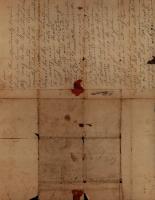 MacKay_Letter_020 Letter from Jenet McKay to her son Mordecai McKay. She tells him about the family and asks how he is doing. January 12, 1808. Transcription: D[ea]r Son I take this opertunaty to write these fue lines to you perhaps they may be the last that I shall trouble you with - I was eighteen months helpless with the Rumatitis payns in which I longs for your vissit but the Lord visited one in mercy and hath restored me to my former health. Your brother John hath a son five months old and his name is William and Hector hath another which he call Daniel three months old. I was in Geenava with the gerls two months and they were doing well and doing well about the about the first November. I returned to Hector’s place at which time I mitt with John Brewer and he informed me that you was a going to saw with Depew for a lost forten - but if so be it appears you have forgot me and all my troubles and distress, but my deer son you may as well go to Law with Mr Depew for your father never had a graspe of pen for land only fair promises and [top line of page cut off] self that I sold my wright to land but to gate learning for my youngest chilldren mongest which you were one - however I shall not believe the report till I have it from your self - I allso herad you was about to take wife how [exciting?] so please to gove me her name on a peace of paper if the world and the carrs thereof will not allow you to com and see me - you know I cannot read riting and nithere do you send me any but believe me i can get good neighbours to read and write for me. I remain your very Affectioned Mother [signed] Jenet McKay NB Daniel is well and hath bult a saw mill and neset [next] summer if he lives he will bult grist mill your Brother in Law Robt Wheley is well and is wife also and hath bult house and bought land within 2 mills [miles] of the mil turn over [turn to next page] it is a large track of good land Robert is teaching school in Big Tree Town Friend are all well [signed] J McKay January 12th 1808 PS Please to let me know if you have news from Philadelphia or any other of my friends o that I could write my mind to you I think of you very often [signed] Jenet McKay To Mordecai McKay
MacKay_Letter_020 Letter from Jenet McKay to her son Mordecai McKay. She tells him about the family and asks how he is doing. January 12, 1808. Transcription: D[ea]r Son I take this opertunaty to write these fue lines to you perhaps they may be the last that I shall trouble you with - I was eighteen months helpless with the Rumatitis payns in which I longs for your vissit but the Lord visited one in mercy and hath restored me to my former health. Your brother John hath a son five months old and his name is William and Hector hath another which he call Daniel three months old. I was in Geenava with the gerls two months and they were doing well and doing well about the about the first November. I returned to Hector’s place at which time I mitt with John Brewer and he informed me that you was a going to saw with Depew for a lost forten - but if so be it appears you have forgot me and all my troubles and distress, but my deer son you may as well go to Law with Mr Depew for your father never had a graspe of pen for land only fair promises and [top line of page cut off] self that I sold my wright to land but to gate learning for my youngest chilldren mongest which you were one - however I shall not believe the report till I have it from your self - I allso herad you was about to take wife how [exciting?] so please to gove me her name on a peace of paper if the world and the carrs thereof will not allow you to com and see me - you know I cannot read riting and nithere do you send me any but believe me i can get good neighbours to read and write for me. I remain your very Affectioned Mother [signed] Jenet McKay NB Daniel is well and hath bult a saw mill and neset [next] summer if he lives he will bult grist mill your Brother in Law Robt Wheley is well and is wife also and hath bult house and bought land within 2 mills [miles] of the mil turn over [turn to next page] it is a large track of good land Robert is teaching school in Big Tree Town Friend are all well [signed] J McKay January 12th 1808 PS Please to let me know if you have news from Philadelphia or any other of my friends o that I could write my mind to you I think of you very often [signed] Jenet McKay To Mordecai McKay -
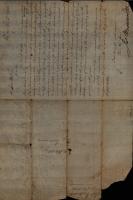 MacKay_Letter_019 Contract stating John McKay will store and process the grain of the “Scotch Settlers” at his mill in exchange for compensation. December 5th, 1806 Transcription: [front] Jas Wadsworth Dec 5th 1806 [inside] Geneseo Dec 5th 1806 Mr. John McKay Dear Sir The Scotch Settlers are instructed to deliver their wheat and Rye provided their contracts allow of the latter (which I do not now recollect) intended to apply in payment of their land at your Mill. You will please to take charge of their grain which they deliver and store it in a place where it will be safe and kept by itself. You will take the grain by weight and recieve none but what is merchantable. You will give to each Settler a receipt for the quantity he delivers and as an encouragement to good husbandry you will mention in each receipt the quality of the grain as either of the first or second quality. You will keep a particular account of all the grain you receive and the time of the delivery. In the season of receiving grain you will regularly every month transmit to Mr. Heslop by Post an account of all the grain you have received, mentioning the Settlers’ name of whom received, the time of delivery and the quality of the grain. Respecting the future disposal of the grain you will receive further instructions. You will be allowed a suitable compensation for your trouble in receiving the grain of the Scotch Settlers. I am Dear Sir Sir with respect Your Obt Servt [signed] Jas Wadsworth
MacKay_Letter_019 Contract stating John McKay will store and process the grain of the “Scotch Settlers” at his mill in exchange for compensation. December 5th, 1806 Transcription: [front] Jas Wadsworth Dec 5th 1806 [inside] Geneseo Dec 5th 1806 Mr. John McKay Dear Sir The Scotch Settlers are instructed to deliver their wheat and Rye provided their contracts allow of the latter (which I do not now recollect) intended to apply in payment of their land at your Mill. You will please to take charge of their grain which they deliver and store it in a place where it will be safe and kept by itself. You will take the grain by weight and recieve none but what is merchantable. You will give to each Settler a receipt for the quantity he delivers and as an encouragement to good husbandry you will mention in each receipt the quality of the grain as either of the first or second quality. You will keep a particular account of all the grain you receive and the time of the delivery. In the season of receiving grain you will regularly every month transmit to Mr. Heslop by Post an account of all the grain you have received, mentioning the Settlers’ name of whom received, the time of delivery and the quality of the grain. Respecting the future disposal of the grain you will receive further instructions. You will be allowed a suitable compensation for your trouble in receiving the grain of the Scotch Settlers. I am Dear Sir Sir with respect Your Obt Servt [signed] Jas Wadsworth -
 MacKay_Letter_015 Deed. Sale of land in Caledonia, New York, from David Walker and Samuel Irvin to James B. McKay. February 11, 1852. Transcription of print and handwriting: [front] David Walker and Samuel Irvin TO James B. McKay Livingston County, ss. Recorded on the 11th day of Feby, 1852, at 4 o’clock. PM, in Liber 42 of Deeds, at page 148, and examined. [signed] [Jerall D. Root?] [page one] This Indenture made this second day of February in the year of our Lord one thousand eight hundred and fifty-two between David Walker and Samuel Irvin Executor of Margaret Simpson late of Caledonia County of Livingston & State of New York [?] being thereunto duly authorized by the last will & testament of the said Margaret of the first part, and James B. McKay of the Town County and State aforesaid- Witnesseth, that the said part is of the first part, in consideration of the sum of Four Hundred dollars - to them duly paid have sold, and By these Presents, do grant and convey to the said party of the second part, his heirs and assigns all that tract or parcel of land, situate in the Village of Caledonia, County and State aforesaid, and described as follows - viz. Being the front part of Village Lots Number four and five, and the north half of Village Lot Number six, being in the whole, ten rods front and fifteen rods deep, containing one hundred and fifty square rods of ground, be the same more or less, being the same property formerly owned and occupied by Isaac J Lewis - Lying on the west side of the Highway heading north, from the Village of Caledonia to the Village of Mumford With the Appurtenances, and all the Estate, Title and Interest therein of the said party of the first part. And the parties of the first part do hereby covenant and agree to and with the said party of the second part, has heirs and assigns, they will forever warrant and defend against any person whomsoever, lawfully claiming the same or any part thereof. In Witness whereof, the said parties of the first part have hereunto set their hands and seals the day and year first above written. Sealed and Delivered in Presence of [signed] David Walker, Samuel Irvin [page 2] State of New York, Livingston County, ss. On this second day of February in the year one thousand eight hundred and fifty two before me the subscriber, personally appeared David Walker & Samuel Ervin to me known to be the persons described in, and who executed the within instrument, and acknowledged that they executed the same. [signed] Alex Ferguson justice of the Peace
MacKay_Letter_015 Deed. Sale of land in Caledonia, New York, from David Walker and Samuel Irvin to James B. McKay. February 11, 1852. Transcription of print and handwriting: [front] David Walker and Samuel Irvin TO James B. McKay Livingston County, ss. Recorded on the 11th day of Feby, 1852, at 4 o’clock. PM, in Liber 42 of Deeds, at page 148, and examined. [signed] [Jerall D. Root?] [page one] This Indenture made this second day of February in the year of our Lord one thousand eight hundred and fifty-two between David Walker and Samuel Irvin Executor of Margaret Simpson late of Caledonia County of Livingston & State of New York [?] being thereunto duly authorized by the last will & testament of the said Margaret of the first part, and James B. McKay of the Town County and State aforesaid- Witnesseth, that the said part is of the first part, in consideration of the sum of Four Hundred dollars - to them duly paid have sold, and By these Presents, do grant and convey to the said party of the second part, his heirs and assigns all that tract or parcel of land, situate in the Village of Caledonia, County and State aforesaid, and described as follows - viz. Being the front part of Village Lots Number four and five, and the north half of Village Lot Number six, being in the whole, ten rods front and fifteen rods deep, containing one hundred and fifty square rods of ground, be the same more or less, being the same property formerly owned and occupied by Isaac J Lewis - Lying on the west side of the Highway heading north, from the Village of Caledonia to the Village of Mumford With the Appurtenances, and all the Estate, Title and Interest therein of the said party of the first part. And the parties of the first part do hereby covenant and agree to and with the said party of the second part, has heirs and assigns, they will forever warrant and defend against any person whomsoever, lawfully claiming the same or any part thereof. In Witness whereof, the said parties of the first part have hereunto set their hands and seals the day and year first above written. Sealed and Delivered in Presence of [signed] David Walker, Samuel Irvin [page 2] State of New York, Livingston County, ss. On this second day of February in the year one thousand eight hundred and fifty two before me the subscriber, personally appeared David Walker & Samuel Ervin to me known to be the persons described in, and who executed the within instrument, and acknowledged that they executed the same. [signed] Alex Ferguson justice of the Peace -
 MacKay_Letter_145 Photograph of John McKay's house in Caledonia, New York with two unknown people, a man and a woman, on the front porch. This house now stands in the Village Green at the Genesee Country Village and Museum. No date.
MacKay_Letter_145 Photograph of John McKay's house in Caledonia, New York with two unknown people, a man and a woman, on the front porch. This house now stands in the Village Green at the Genesee Country Village and Museum. No date. -
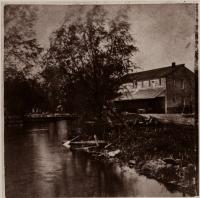 MacKay_Letter_144 This photo is not labeled but it is most likely a photo of John McKay's flour mill in Avon, New York. No date.
MacKay_Letter_144 This photo is not labeled but it is most likely a photo of John McKay's flour mill in Avon, New York. No date. -
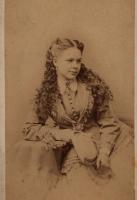 MacKay_Letter_143 Ellen Hutchinson was a literary editor for the Tribune in New York City. She was married to a famous art critic named Royal Cortissoz. He wrote the epithet above Lincoln's statue at the Lincoln Memorial. Her parents were Joslyn Hutchinson and Jennet McKay Hutchinson. Photo not dated. Transcription: [Written along edge] Nellie Hutchinson [at top] Ellen Mckay Hutchinson, Daughter of Janet {Jennet] McKay Hutchinson - granddaughter of John McKay wife of Royal Cortissoz art-critic of NY Tribune. [signed] Jessie McVean
MacKay_Letter_143 Ellen Hutchinson was a literary editor for the Tribune in New York City. She was married to a famous art critic named Royal Cortissoz. He wrote the epithet above Lincoln's statue at the Lincoln Memorial. Her parents were Joslyn Hutchinson and Jennet McKay Hutchinson. Photo not dated. Transcription: [Written along edge] Nellie Hutchinson [at top] Ellen Mckay Hutchinson, Daughter of Janet {Jennet] McKay Hutchinson - granddaughter of John McKay wife of Royal Cortissoz art-critic of NY Tribune. [signed] Jessie McVean -
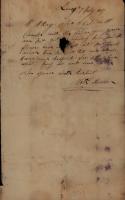 MacKay_Letter_142 Letter from Matthew Mason to John McKay letting him know he was not paid for a flour order he delivered. July 1, 1817. Leroy 1 July 1817 Mr McKay sir I called on Mr Crooks with the order you gave me but got no money he said the flower was not all sold but how much he did not tell me which I was much disapointed for I thot he would pay for wat was sold Sir yours with respect [signed] Math Mason
MacKay_Letter_142 Letter from Matthew Mason to John McKay letting him know he was not paid for a flour order he delivered. July 1, 1817. Leroy 1 July 1817 Mr McKay sir I called on Mr Crooks with the order you gave me but got no money he said the flower was not all sold but how much he did not tell me which I was much disapointed for I thot he would pay for wat was sold Sir yours with respect [signed] Math Mason -
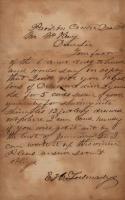 MacKay_Letter_141 Letter to Mr. McKay offering a trade of Delaware Wine for 5 cords of Cedar. Dec 12, unknown year. Transcription: Pavilion Center Dec 12th Mr McKay Dear Sir Your favor of the 6 came [?] to hand and would say in reply that I will give you 10 gallons of Delaware wine 2 years old for 5 cords sedur [cedar] of good quality for shaving into shingles 12 feet long drawed out where I can load handy if you will get it out by the last if Januery so I can work it up this winter Pleas answer soon & oblige E. H. [*mady?]
MacKay_Letter_141 Letter to Mr. McKay offering a trade of Delaware Wine for 5 cords of Cedar. Dec 12, unknown year. Transcription: Pavilion Center Dec 12th Mr McKay Dear Sir Your favor of the 6 came [?] to hand and would say in reply that I will give you 10 gallons of Delaware wine 2 years old for 5 cords sedur [cedar] of good quality for shaving into shingles 12 feet long drawed out where I can load handy if you will get it out by the last if Januery so I can work it up this winter Pleas answer soon & oblige E. H. [*mady?] -
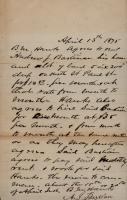 MacKay_Letter_140 Agreement between B. M. Hauks and Andrew J Bastian. Hauks will rent his land to Bastian and also hire him to work. April 13, 1875. Transcription: April 13, 1875 B.M. Hauks agrees to rent Andrew J Bastion his horse and lot of land 50’ x 200” deep on north of Paul St for $12.00 per month and at that rate from month to month - Hauks also agrees to hire said Bastian for [?] month at $35 per month - & from month to month at the same rate or as they may hereafter agree said Bastian agrees to pay said monthly rent. & work for said Hauks - the service to commence - about the 15th or 20th of April Inst. [signed] B.M. Hauks [signed] A.J. Bastian
MacKay_Letter_140 Agreement between B. M. Hauks and Andrew J Bastian. Hauks will rent his land to Bastian and also hire him to work. April 13, 1875. Transcription: April 13, 1875 B.M. Hauks agrees to rent Andrew J Bastion his horse and lot of land 50’ x 200” deep on north of Paul St for $12.00 per month and at that rate from month to month - Hauks also agrees to hire said Bastian for [?] month at $35 per month - & from month to month at the same rate or as they may hereafter agree said Bastian agrees to pay said monthly rent. & work for said Hauks - the service to commence - about the 15th or 20th of April Inst. [signed] B.M. Hauks [signed] A.J. Bastian -
 MacKay_Letter_139 The name of the sender and receiver are not included. It mentions a McKay who died in South Africa and heirs are being searched for. The letter ends abruptly and the rest of the letter is missing. No date. Transcription: Caledonia, N.Y. 189 This appeared in a Cleveland paper Nov. 4th 1894 Portland, Ore. Nov. 3. If the facts bear out the obligations then several persons in Portland Oakland and San Francisco, are heir to a South African estate of vast value. The estate in question is that of William McKay who is known to have died. Possessed of great wealth his own appraisement being it is said 15 millions McKay was a Scotchman of an adventurous turn of mind who lived at the Kimberly diamond fields and who in dying bequeathed his fortune to his brothers and sisters eight in number whos progeny are scattered almost to the four corners of the earth. They are well represented in Portland. Morrison a nephew of the deceased residing in St. Johns N.M. is looking after the interest of the heirs in this country it is said that the will was first brought to Schotland by John Collins one of the witnesses of the document was searching for Daniel McKay a brother of the
MacKay_Letter_139 The name of the sender and receiver are not included. It mentions a McKay who died in South Africa and heirs are being searched for. The letter ends abruptly and the rest of the letter is missing. No date. Transcription: Caledonia, N.Y. 189 This appeared in a Cleveland paper Nov. 4th 1894 Portland, Ore. Nov. 3. If the facts bear out the obligations then several persons in Portland Oakland and San Francisco, are heir to a South African estate of vast value. The estate in question is that of William McKay who is known to have died. Possessed of great wealth his own appraisement being it is said 15 millions McKay was a Scotchman of an adventurous turn of mind who lived at the Kimberly diamond fields and who in dying bequeathed his fortune to his brothers and sisters eight in number whos progeny are scattered almost to the four corners of the earth. They are well represented in Portland. Morrison a nephew of the deceased residing in St. Johns N.M. is looking after the interest of the heirs in this country it is said that the will was first brought to Schotland by John Collins one of the witnesses of the document was searching for Daniel McKay a brother of the -
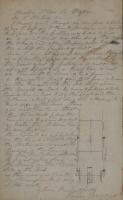 MacKay_Letter_134 Letter from James Douglass to J McKay relaying to him a new mechanical method he has planned that he thinks will make milling wheat more efficient. On the lower right he has drawn a sketch of how the machinery should be set up. No date. Transcription: Memphis St. Clair Co Michigan Mr J McKay Sir I received yours through my son from Alexander when I left you I came to Michigan and agreed to Superintend the putting in of 4 new wheels in a grist mill am now doing the work the wheels and other repairs will take me until the fore part of Sept - Since I was at your place I have thought of a plan that your mill might run by the Scroll Wheel by putting a wheel on an upright shaft and Bevel Cone wheel on the shaft to mash in to a pinion on a horizontal shaft and belt from a drum on the horizontal to the saw shaft under the sawgate on sash - by having 2 pitmans and 2 cranks one on each end of the shaft and the pitmans about 9 feet long and attaching to each side of the sash thus you will then ceive wheat thus made will place the cranks up high and dry out of roater the pitmans can be very light - There should be 2 fly wheels on the crank shaft to steady the motion and prevent the backlash of the gearing saw on sash should run on rods to prevent getting loose the bearing on the backside of the sash in this [?] you could do business with a very little water Yours Respectfully [signed] James Douglass
MacKay_Letter_134 Letter from James Douglass to J McKay relaying to him a new mechanical method he has planned that he thinks will make milling wheat more efficient. On the lower right he has drawn a sketch of how the machinery should be set up. No date. Transcription: Memphis St. Clair Co Michigan Mr J McKay Sir I received yours through my son from Alexander when I left you I came to Michigan and agreed to Superintend the putting in of 4 new wheels in a grist mill am now doing the work the wheels and other repairs will take me until the fore part of Sept - Since I was at your place I have thought of a plan that your mill might run by the Scroll Wheel by putting a wheel on an upright shaft and Bevel Cone wheel on the shaft to mash in to a pinion on a horizontal shaft and belt from a drum on the horizontal to the saw shaft under the sawgate on sash - by having 2 pitmans and 2 cranks one on each end of the shaft and the pitmans about 9 feet long and attaching to each side of the sash thus you will then ceive wheat thus made will place the cranks up high and dry out of roater the pitmans can be very light - There should be 2 fly wheels on the crank shaft to steady the motion and prevent the backlash of the gearing saw on sash should run on rods to prevent getting loose the bearing on the backside of the sash in this [?] you could do business with a very little water Yours Respectfully [signed] James Douglass -
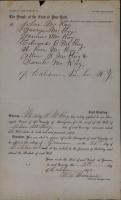 MacKay_Letter_133 Letter announcing to the family of John McKay Jr. the date and time they are to attend the probate of his will. John McKay Jr. died June 1, 1878. October 7, 1878. Transcription: Citation to attend probate and will To John McKay Geroge McKay Jennie McKay Edward B. McKay A. Rose McKay Allen B. McKay & Sarah McKay Of Caledonia Liv. Co. N. Y. Whereas Mary S. McKay has lately applied to our Surrogate Court of Livingston, for the proof of the Will of Johns McKay late of said County, deceased, which said Will relates to both real and personal estate. Therefore you are cited to appear before the Surrogate of said County, at his office in the village of Geneseo on the 21st day of October inst at 10 o’clock in the forenoon of that day, and attend the Probate of said Will. Given Under the Seal of said Court, at Geneseo, in said County, the 7th day of October 1878 [signed] W. T. Howard
MacKay_Letter_133 Letter announcing to the family of John McKay Jr. the date and time they are to attend the probate of his will. John McKay Jr. died June 1, 1878. October 7, 1878. Transcription: Citation to attend probate and will To John McKay Geroge McKay Jennie McKay Edward B. McKay A. Rose McKay Allen B. McKay & Sarah McKay Of Caledonia Liv. Co. N. Y. Whereas Mary S. McKay has lately applied to our Surrogate Court of Livingston, for the proof of the Will of Johns McKay late of said County, deceased, which said Will relates to both real and personal estate. Therefore you are cited to appear before the Surrogate of said County, at his office in the village of Geneseo on the 21st day of October inst at 10 o’clock in the forenoon of that day, and attend the Probate of said Will. Given Under the Seal of said Court, at Geneseo, in said County, the 7th day of October 1878 [signed] W. T. Howard -
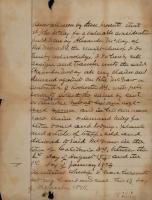 MacKay_Letter_132 Agreement stating that John McKay (most likely John McKay Jr.) sold Alexander McKay the debt owed to him by Peter McGraw. December 15, 1875. Note: this agreement is referenced in MacKay_Letter_070 and would have originally been included with that letter. Transcription: Know all men by these presents that I John McKay for a valuable consideration paid to me by Alexander McKay, of Mt. Morris, N. Y. the receipt thereof I do hereby acknowledge. I so hereby sell assign and transfer unto the said Alexander McKay all my claim and demand against one Peter McGraw a contractor of Rochester N. Y. with full power to collect the same by suit or otherwise out of his own cost and expense, and in his own name said claim or demand being for store board and lodging, plank and articles of traffic sold and delivered to said McGraw in the town of Caledonia N.Y. between the 14th day of August 1872 and the 14th day of January 1873 In witness whereof I have herewith set my hand and seal this 15th day of December 1875. [signed] John McKay
MacKay_Letter_132 Agreement stating that John McKay (most likely John McKay Jr.) sold Alexander McKay the debt owed to him by Peter McGraw. December 15, 1875. Note: this agreement is referenced in MacKay_Letter_070 and would have originally been included with that letter. Transcription: Know all men by these presents that I John McKay for a valuable consideration paid to me by Alexander McKay, of Mt. Morris, N. Y. the receipt thereof I do hereby acknowledge. I so hereby sell assign and transfer unto the said Alexander McKay all my claim and demand against one Peter McGraw a contractor of Rochester N. Y. with full power to collect the same by suit or otherwise out of his own cost and expense, and in his own name said claim or demand being for store board and lodging, plank and articles of traffic sold and delivered to said McGraw in the town of Caledonia N.Y. between the 14th day of August 1872 and the 14th day of January 1873 In witness whereof I have herewith set my hand and seal this 15th day of December 1875. [signed] John McKay -
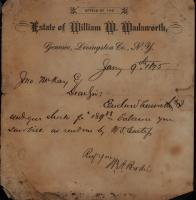 MacKay_Letter_131 Payment to John McKay (most likely John McKay Jr.) from W. O. Curty for $189.88. Sent by Wm A. Brodie on the letterhead of William W. Wadsworth. January 9, 1875. [letterhead] Estate of William W. Wadsworth Geneseo, Livingston Co., N. Y. [Transcription] Jany 9th 1875 Jno McKay Esq Dear Sir: Enclosed herewith I send you check for 189.88 balance your lawbill as send me by W. O. Curty Res you Wm A. Brodie
MacKay_Letter_131 Payment to John McKay (most likely John McKay Jr.) from W. O. Curty for $189.88. Sent by Wm A. Brodie on the letterhead of William W. Wadsworth. January 9, 1875. [letterhead] Estate of William W. Wadsworth Geneseo, Livingston Co., N. Y. [Transcription] Jany 9th 1875 Jno McKay Esq Dear Sir: Enclosed herewith I send you check for 189.88 balance your lawbill as send me by W. O. Curty Res you Wm A. Brodie -
 MacKay_Letter_130 Letter from R C Wright to John McKay Jr. offering to sell him some millstones for $75. July 14 1869. Transcription: Richmond Mills July 14 1869 John McKay Dear Sir, I was informed that you was at my place for the pirpus [purpose] of binng [buying] a set of mill stone I have to sell and I will take 75 Dollors for the [stones?] if you wahnt them please come and get them within 10 days as I am about [seling?] I want to get them out of the mill Your Respt [signed] R. C. Wright
MacKay_Letter_130 Letter from R C Wright to John McKay Jr. offering to sell him some millstones for $75. July 14 1869. Transcription: Richmond Mills July 14 1869 John McKay Dear Sir, I was informed that you was at my place for the pirpus [purpose] of binng [buying] a set of mill stone I have to sell and I will take 75 Dollors for the [stones?] if you wahnt them please come and get them within 10 days as I am about [seling?] I want to get them out of the mill Your Respt [signed] R. C. Wright -
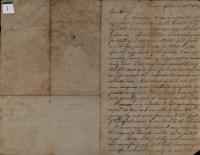 MacKay_Letter_127 Letter from Joslyn Hutchinson to his brother in law John McKay Jr. Hutchinson was married to Jennet McKay. John Jr. and Jennet were the children of John McKay Sr. Sent from London, Joslyn explains he has been very ill so has not made his way back to the United States yet but that he is feeling better so should travel soon. March 20th 1856. Transcription: [page 1] London, March 20th 1856 Dear John, Several weeks ago I entertained the hope that I should re-cross the Atlantic long before this, but my intentions were again thwarted by sickness. About the time I had designated for starting I was again attacked with fever and at one period I was low that I was upon the very brink of the grave. I am now recovering however, but my improvement is necessarily slow. I am very much emancipated, my strength seems quite gone, for I am as weak as an infant, and the least exertion wearies and exhausts me. But thank fortune all the more dangerous and threatening symptoms have passed away, and time patience and care will gradually work a change for the better. It is now my intention to set out on my return as soon as I am able to bear the journey by rail-road from here to the port of Liverpool where I would take the steamer. It is now my hope that I may acquire the requisite strength within ten or fourteen days. George will probably meet me here and accompany me so I shall have one with me upon whom I can rely in case I should [page 2] have a relapse during the voyage. My constitution has been so shattered by my sickness during the winter that it would no doubt be extremely hazardous, and an act of most reckless folly for me to attempt to return to California immediately after landing at New York, as I had contemplated. I would necessarily have to pass some time within the tropics, and such an exposure in my enfeebled state would probably be attended with fatal consequences. I have therefore concluded to stop a for a few weeks at and about my old home in order to recruit my health before I venture to go on. So you may look for me again in Caledonia, but I fear that I shall be so thin that you will scarcely know me. I write you at this time lest you might entertain some serious apprehensions on account of my long silence. I am compelled to be brief - I trust that within a fortnight or three weeks after this reaches you I shall have the satisfaction of greeting you in person. Give my love to all the family and remember me to Judge Smith [page 3] and other friends. Rest assured John I remain as ever Yours affectionately [signed] Joslyn Hutchinson Capt. John Mackay Caledonia Livingston County N.Y. P.S. I enclose this in a note & am about to send to a friend in New York City, so you need not be surprised to see it post-marked New York J. H.
MacKay_Letter_127 Letter from Joslyn Hutchinson to his brother in law John McKay Jr. Hutchinson was married to Jennet McKay. John Jr. and Jennet were the children of John McKay Sr. Sent from London, Joslyn explains he has been very ill so has not made his way back to the United States yet but that he is feeling better so should travel soon. March 20th 1856. Transcription: [page 1] London, March 20th 1856 Dear John, Several weeks ago I entertained the hope that I should re-cross the Atlantic long before this, but my intentions were again thwarted by sickness. About the time I had designated for starting I was again attacked with fever and at one period I was low that I was upon the very brink of the grave. I am now recovering however, but my improvement is necessarily slow. I am very much emancipated, my strength seems quite gone, for I am as weak as an infant, and the least exertion wearies and exhausts me. But thank fortune all the more dangerous and threatening symptoms have passed away, and time patience and care will gradually work a change for the better. It is now my intention to set out on my return as soon as I am able to bear the journey by rail-road from here to the port of Liverpool where I would take the steamer. It is now my hope that I may acquire the requisite strength within ten or fourteen days. George will probably meet me here and accompany me so I shall have one with me upon whom I can rely in case I should [page 2] have a relapse during the voyage. My constitution has been so shattered by my sickness during the winter that it would no doubt be extremely hazardous, and an act of most reckless folly for me to attempt to return to California immediately after landing at New York, as I had contemplated. I would necessarily have to pass some time within the tropics, and such an exposure in my enfeebled state would probably be attended with fatal consequences. I have therefore concluded to stop a for a few weeks at and about my old home in order to recruit my health before I venture to go on. So you may look for me again in Caledonia, but I fear that I shall be so thin that you will scarcely know me. I write you at this time lest you might entertain some serious apprehensions on account of my long silence. I am compelled to be brief - I trust that within a fortnight or three weeks after this reaches you I shall have the satisfaction of greeting you in person. Give my love to all the family and remember me to Judge Smith [page 3] and other friends. Rest assured John I remain as ever Yours affectionately [signed] Joslyn Hutchinson Capt. John Mackay Caledonia Livingston County N.Y. P.S. I enclose this in a note & am about to send to a friend in New York City, so you need not be surprised to see it post-marked New York J. H. -
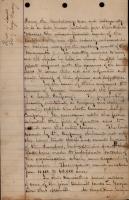 MacKay_Letter_126 Report on land in Georgia that was either being sold to, or sold by, George MacKay. Unknown writer. No date. Transcription: [Written diagonally] Report on Land sold by George MacKay [page 1] During the revolutionary war and subsequently, it is a well known historical fact that Robert Morriss the eminent financial agent of the United States, was often seriously embarrassed in raising money for the necessary wants of the government. In converting measures to carry out the object he had in view, he often held private conferences with the governors of the several states to secure their aid and cooperation and avail himself of their opinions and suggestions. In the course of these conferences the governor of Georgia recommended the formation of a Sand Company. The project being favorably entertained, a company was duly formed entitled the North American Sand Company. In accordance with the plan submitted, their field of operations was to extend over the entire Union. The lands secured by the Company embraced not only the large tracts that were owned by many of the members, but extensive grants that had been made to individuals outside of the organization, which were acquired by purchase. These grants varied in extent from 10.000 to 60.000 acres. In their transactions several millions of acres of the pine timbered lands in Georgia were thus obtained. At that time Georgia [page 2] was more sparsely inhabited than either of the States that originally entered into the confederation. Owing to this and to the fact that the cultivation of those products that formed the great states of the Southern States was chiefly confined to the alluvial valleys or “bottom lands”, no market was found for these uplands bearing their heavy and luxuriant growth of fine pine. For upwards of half a century but a few of the more insignificant of the grants were sold. It is true that the products of the vast forest of the southern pine - the ship-timber, the lumber, the pitch, tar, turpentine and rosin, became well known in the commerce of the world, the demand for which was immense even in the remotest parts of the civilized portions of the globe. But the supply of these was, during all these earlier years, mainly drawn from North and South Carolina simply because they had the first advantage of a greater population, and as their soil did not yield as generously as that farther south, they directed their attention more especially to their pine forests, and thus secured for two or three successive generations almost the exclusive control of the trade [page 3] in their products. Thus through all the great commercial marts the control of this important trade was yielded to the Carolinas through the best judges and experts in these very products knew by thorough test and examination that the very finest portion (in every sense) of what is termed the “great pine belt” is in the state of Georgia. The timber at this extremity of the “belt” is of larger and finer growth than upon those portions farther north. This is now not only generally known, but from the fact that most of the timber upon the coast remains intact while all that upon the more northern parts of the “belt” is either cut off or the more valuable portion in all those districts accessible from the coast is culled out, all serves to give a special value and importance to these Georgian pine lands. I have thoroughly examined all the tracts conveyed to you, and from careful measurement and repeated counts in every part I have no hesitation in assuring you that there are on an average fifteen large pines ranging from two to five feet in diameter at the butt, to every acre. [page 4] At the very lowest computation, and allowing the highest rates for placing the timber in market, you will be at no loss to perceive that a return in profits could be realized alike so safe and so gigantic, that no investment that could be offered or found in any part of the world, could bear any comparison with it. As to the products pitch, tar, turpentine and resin, - those are so well known, and the demand for them so universal as to make all comment needless. As to the timber I will further make only a brief allusion. I have already set forth the average quantity to the acre. In no other section of the “belt” is it of so fine as grain and quality. It admits of a smoother dress and is more durable. For masts of vessels, for decks and the upper frame-work and planking, and in buildings when used for beams, studs, joists, frames, flooring and substantial wainscoting it is not equaled or even approached by any other timber or lumber in use, in all those essential qualities of adaptability, beauty, strength and durability. One other point I would refer to is being of no little importance, - that is the smallest trees and the upper portions of the larger ones would always find a ready market for railroad ties. For [page 5] that purpose, in the requisites of firmness and strength and non-liability to crack or split, they are equal to the best oaks. At the same time they will last on an average at least four times as long as those of oaks, - will hold the spike firmer and better, as it never rusts in the pine, and as the pores are never penetrated by water or dampness they are not subject to rot. In all the better class of southern railroads having access to the pine region, wherever the oak ties were originally laid, they have been taken up and those of pine substituted. They have invariably given the utmost satisfaction and proved as herein recommended. For bridge-work it surpasses any other timber. Indeed such is the demand for timber for railroad-works, that if all the trees upon these lands, notwithstanding they are of greater value for other purposes, were appropriated to the railroads under construction or repair, within the more accessible range of markets, the smallest return would be more than a hundred fold the cost, in net profit. As to the surveys- they were originally made with great care and accuracy by order and under the authority of the state. [page 6] See the details thereof were made full and complete in the records and files of the Sand Office at the Capitol. These surveys always preceded the grants, and the same precision and care were exercised in making the boundary lines distinct and visible to any ordinary observer as were subsequently carried out under the perfect land system of the general government. Consequently there was never a conflict of grants, and where any two or more were contiguous, the dividing lines were always easily traced by referring not only to the maps issued from the Sand Office, but to the peculiar marks always made upon the trees on these lines. The starting points are landmarks, even when away from an easily designated part of a stream or some conspicuous land or rock formation can be readily distinguished by anyone that becomes at all familiar with the country. Should however any confusion, doubt or uncertainty arise, and the usual information to be obtained not at hand, a brief reference to the state archives in the Sand Office would at once settle and adjust all. All the lands were surveyed into squares or lots of one thousand acres each, and the plan of surveys was so [page 7] fully and plainly delineated that no subsequent rectification or substitution was ever rendered necessary. Natural objects, streams, every thing indeed that would serve as a guide to identification were carefully noted. I became early acquainted with the land system of Georgia. So plain were the lines of all these surveys I conveyed to you, that I easily and uninterruptedly ran them all horseback at the time of my purchase. The marks upon the trees with the bearings as taken by a common pocket compass made it plain and facile work. Even if the landmarks should be obliterated or destroyed, sufficient data could readily be found at the Sand Office when no information can be obtained in the neighborhood, that would clearly adjust every uncertain or controverted point. The title having originally emanated from the State and the chain being unbroken down to yourself, its validity cannot be questioned. This view is corroborated by eminent lawyers whose opinions have been expressed in writing after a full investigation of the facts and examination of the papers. The face of the country embracing [page 8] these lands is nearly level, with comparatively slight undulations, sufficient for good drainage. All is upland and no swamps. The tracts are generally well watered, and are mostly accessible from the coast by streams, down which the timber can be either floated or transported in boats to the shipping in the harbors. Whenever there is a range of timber that cannot be reached by a stream, train roads can be inexpensively laid upon which horse trucks, constructed for the purpose can be run for the conveyance of the timber to navigable waters. Among the timber there is no underbrush consequently there is no impediment to riding or driving over the tracts through the forest excepting that presented by the streams. The surface, unlike our northern forests, apart from the trees, is generally covered with a native grass, which makes it well adapted to grazing without injury to the timber. The soil is a sandy loam. When the timber is cut off, the stumps not being perishable, they can be readily drawn from the earth by an ordinary stump machine worked by cattle or horses. When thus drawn out they can be used either in enclosing fields [page 9] in lieu of ordinary fencing, or be converted into fuel. They might also in connection with the branches and tops cut from the main tops be used in the manufacture of tar. It can thus be seen that there need be no portion of the tree wasted. The lands will prove valuable after being deprived of the timber. The soil is easily worked and handsomely repays tillage. According to the amount of labor expended upon it, the products are as remunerative as those raised upon the heavier or the alluvial soils. On the score of fruits it produces in perfection apples, pears, peaches, cherries, apricots, plums, nectarines, figs, limes and oranges. Grapes of all the best varieties from the Isabella, Diana and Catawba to the Hamburgh, Scuppernong and Malaga yield abundantly and mature perfectly. All the ordinary grains, garden vegetables, small fruits and roots are produced. Sugar cane can be profitably grown. Indeed it is customary for the small farmers in the neighborhood of these tracts to cultivate small patches of cane, which is crushed by a crude and inexpensive process and the juice thence obtained is converted into syrup and sugar for their consumption over their kitchen fires. Ground or pea nuts yield largely [page 10] and can be made profitable either in fattening swine, or by exportation. Sweet potatoes can likewise be made to return ample profits as they are invariably of the finest quality. But one of the greatest and richest sources of income from these lands when duly improved, would be the cultivation of the long staple or Sea Island cotton. With ordinary care and effort an average production of half a bale to the acre can be safely counted upon. As this always commands in market from three to four times the price of the ordinary on short staple cotton, it will thus be seen that these lands when ready for cultivation are quite as profitable and therefore as desirable as the rich alluvions, upon which only the short staple can be grown. In fact these pine lands might be said to be preferable, as they have greater salubrity of climate and the crops are generally surer. The climate is mild, corresponding with that of southern Spain and Italy. The heat is not intense in the summer and is generally more enjoyable than the same season farther north. It is not subject to sudden or severe changes. In the winter the temperature is so genial that [page 11] there is rarely any interruption to the grazing in the pastures. From this fact alone stock raising could be deemed one of the most profitable branches of husbandry. In healthiness of climate these pine lands are as exempt from bilious diseases and are favorable to robust health and maturity as those well known [hole in paper] or mountainous districts remote from the coast. These lands have the advantage of being alike profitable whether farmed upon a large or a small scale. It may be said that they offer a double inducement to the purchaser - first from the immense returns, already referred to, to be realized from the timber - second from their conversion into productive farms. And as the opportunity for making a like investment are already much circumscribed, and are becoming more and more rare every succeeding year, it may be safely assumed that no such opening so rich, so safe and so promising in every point of view could again be found either in this or any other country.
MacKay_Letter_126 Report on land in Georgia that was either being sold to, or sold by, George MacKay. Unknown writer. No date. Transcription: [Written diagonally] Report on Land sold by George MacKay [page 1] During the revolutionary war and subsequently, it is a well known historical fact that Robert Morriss the eminent financial agent of the United States, was often seriously embarrassed in raising money for the necessary wants of the government. In converting measures to carry out the object he had in view, he often held private conferences with the governors of the several states to secure their aid and cooperation and avail himself of their opinions and suggestions. In the course of these conferences the governor of Georgia recommended the formation of a Sand Company. The project being favorably entertained, a company was duly formed entitled the North American Sand Company. In accordance with the plan submitted, their field of operations was to extend over the entire Union. The lands secured by the Company embraced not only the large tracts that were owned by many of the members, but extensive grants that had been made to individuals outside of the organization, which were acquired by purchase. These grants varied in extent from 10.000 to 60.000 acres. In their transactions several millions of acres of the pine timbered lands in Georgia were thus obtained. At that time Georgia [page 2] was more sparsely inhabited than either of the States that originally entered into the confederation. Owing to this and to the fact that the cultivation of those products that formed the great states of the Southern States was chiefly confined to the alluvial valleys or “bottom lands”, no market was found for these uplands bearing their heavy and luxuriant growth of fine pine. For upwards of half a century but a few of the more insignificant of the grants were sold. It is true that the products of the vast forest of the southern pine - the ship-timber, the lumber, the pitch, tar, turpentine and rosin, became well known in the commerce of the world, the demand for which was immense even in the remotest parts of the civilized portions of the globe. But the supply of these was, during all these earlier years, mainly drawn from North and South Carolina simply because they had the first advantage of a greater population, and as their soil did not yield as generously as that farther south, they directed their attention more especially to their pine forests, and thus secured for two or three successive generations almost the exclusive control of the trade [page 3] in their products. Thus through all the great commercial marts the control of this important trade was yielded to the Carolinas through the best judges and experts in these very products knew by thorough test and examination that the very finest portion (in every sense) of what is termed the “great pine belt” is in the state of Georgia. The timber at this extremity of the “belt” is of larger and finer growth than upon those portions farther north. This is now not only generally known, but from the fact that most of the timber upon the coast remains intact while all that upon the more northern parts of the “belt” is either cut off or the more valuable portion in all those districts accessible from the coast is culled out, all serves to give a special value and importance to these Georgian pine lands. I have thoroughly examined all the tracts conveyed to you, and from careful measurement and repeated counts in every part I have no hesitation in assuring you that there are on an average fifteen large pines ranging from two to five feet in diameter at the butt, to every acre. [page 4] At the very lowest computation, and allowing the highest rates for placing the timber in market, you will be at no loss to perceive that a return in profits could be realized alike so safe and so gigantic, that no investment that could be offered or found in any part of the world, could bear any comparison with it. As to the products pitch, tar, turpentine and resin, - those are so well known, and the demand for them so universal as to make all comment needless. As to the timber I will further make only a brief allusion. I have already set forth the average quantity to the acre. In no other section of the “belt” is it of so fine as grain and quality. It admits of a smoother dress and is more durable. For masts of vessels, for decks and the upper frame-work and planking, and in buildings when used for beams, studs, joists, frames, flooring and substantial wainscoting it is not equaled or even approached by any other timber or lumber in use, in all those essential qualities of adaptability, beauty, strength and durability. One other point I would refer to is being of no little importance, - that is the smallest trees and the upper portions of the larger ones would always find a ready market for railroad ties. For [page 5] that purpose, in the requisites of firmness and strength and non-liability to crack or split, they are equal to the best oaks. At the same time they will last on an average at least four times as long as those of oaks, - will hold the spike firmer and better, as it never rusts in the pine, and as the pores are never penetrated by water or dampness they are not subject to rot. In all the better class of southern railroads having access to the pine region, wherever the oak ties were originally laid, they have been taken up and those of pine substituted. They have invariably given the utmost satisfaction and proved as herein recommended. For bridge-work it surpasses any other timber. Indeed such is the demand for timber for railroad-works, that if all the trees upon these lands, notwithstanding they are of greater value for other purposes, were appropriated to the railroads under construction or repair, within the more accessible range of markets, the smallest return would be more than a hundred fold the cost, in net profit. As to the surveys- they were originally made with great care and accuracy by order and under the authority of the state. [page 6] See the details thereof were made full and complete in the records and files of the Sand Office at the Capitol. These surveys always preceded the grants, and the same precision and care were exercised in making the boundary lines distinct and visible to any ordinary observer as were subsequently carried out under the perfect land system of the general government. Consequently there was never a conflict of grants, and where any two or more were contiguous, the dividing lines were always easily traced by referring not only to the maps issued from the Sand Office, but to the peculiar marks always made upon the trees on these lines. The starting points are landmarks, even when away from an easily designated part of a stream or some conspicuous land or rock formation can be readily distinguished by anyone that becomes at all familiar with the country. Should however any confusion, doubt or uncertainty arise, and the usual information to be obtained not at hand, a brief reference to the state archives in the Sand Office would at once settle and adjust all. All the lands were surveyed into squares or lots of one thousand acres each, and the plan of surveys was so [page 7] fully and plainly delineated that no subsequent rectification or substitution was ever rendered necessary. Natural objects, streams, every thing indeed that would serve as a guide to identification were carefully noted. I became early acquainted with the land system of Georgia. So plain were the lines of all these surveys I conveyed to you, that I easily and uninterruptedly ran them all horseback at the time of my purchase. The marks upon the trees with the bearings as taken by a common pocket compass made it plain and facile work. Even if the landmarks should be obliterated or destroyed, sufficient data could readily be found at the Sand Office when no information can be obtained in the neighborhood, that would clearly adjust every uncertain or controverted point. The title having originally emanated from the State and the chain being unbroken down to yourself, its validity cannot be questioned. This view is corroborated by eminent lawyers whose opinions have been expressed in writing after a full investigation of the facts and examination of the papers. The face of the country embracing [page 8] these lands is nearly level, with comparatively slight undulations, sufficient for good drainage. All is upland and no swamps. The tracts are generally well watered, and are mostly accessible from the coast by streams, down which the timber can be either floated or transported in boats to the shipping in the harbors. Whenever there is a range of timber that cannot be reached by a stream, train roads can be inexpensively laid upon which horse trucks, constructed for the purpose can be run for the conveyance of the timber to navigable waters. Among the timber there is no underbrush consequently there is no impediment to riding or driving over the tracts through the forest excepting that presented by the streams. The surface, unlike our northern forests, apart from the trees, is generally covered with a native grass, which makes it well adapted to grazing without injury to the timber. The soil is a sandy loam. When the timber is cut off, the stumps not being perishable, they can be readily drawn from the earth by an ordinary stump machine worked by cattle or horses. When thus drawn out they can be used either in enclosing fields [page 9] in lieu of ordinary fencing, or be converted into fuel. They might also in connection with the branches and tops cut from the main tops be used in the manufacture of tar. It can thus be seen that there need be no portion of the tree wasted. The lands will prove valuable after being deprived of the timber. The soil is easily worked and handsomely repays tillage. According to the amount of labor expended upon it, the products are as remunerative as those raised upon the heavier or the alluvial soils. On the score of fruits it produces in perfection apples, pears, peaches, cherries, apricots, plums, nectarines, figs, limes and oranges. Grapes of all the best varieties from the Isabella, Diana and Catawba to the Hamburgh, Scuppernong and Malaga yield abundantly and mature perfectly. All the ordinary grains, garden vegetables, small fruits and roots are produced. Sugar cane can be profitably grown. Indeed it is customary for the small farmers in the neighborhood of these tracts to cultivate small patches of cane, which is crushed by a crude and inexpensive process and the juice thence obtained is converted into syrup and sugar for their consumption over their kitchen fires. Ground or pea nuts yield largely [page 10] and can be made profitable either in fattening swine, or by exportation. Sweet potatoes can likewise be made to return ample profits as they are invariably of the finest quality. But one of the greatest and richest sources of income from these lands when duly improved, would be the cultivation of the long staple or Sea Island cotton. With ordinary care and effort an average production of half a bale to the acre can be safely counted upon. As this always commands in market from three to four times the price of the ordinary on short staple cotton, it will thus be seen that these lands when ready for cultivation are quite as profitable and therefore as desirable as the rich alluvions, upon which only the short staple can be grown. In fact these pine lands might be said to be preferable, as they have greater salubrity of climate and the crops are generally surer. The climate is mild, corresponding with that of southern Spain and Italy. The heat is not intense in the summer and is generally more enjoyable than the same season farther north. It is not subject to sudden or severe changes. In the winter the temperature is so genial that [page 11] there is rarely any interruption to the grazing in the pastures. From this fact alone stock raising could be deemed one of the most profitable branches of husbandry. In healthiness of climate these pine lands are as exempt from bilious diseases and are favorable to robust health and maturity as those well known [hole in paper] or mountainous districts remote from the coast. These lands have the advantage of being alike profitable whether farmed upon a large or a small scale. It may be said that they offer a double inducement to the purchaser - first from the immense returns, already referred to, to be realized from the timber - second from their conversion into productive farms. And as the opportunity for making a like investment are already much circumscribed, and are becoming more and more rare every succeeding year, it may be safely assumed that no such opening so rich, so safe and so promising in every point of view could again be found either in this or any other country. -
 MacKay_Letter_123 Letter from Isaac N. Coffin of Brooklyn to Colonel Geroge W. Mackay discussing a Steam Ship Company that Mackay was involved in. The Company seems to have dissolved or stopped and Coffin needs very specific information regarding the company so as to advise Mr. MacKay. April 9, 1827. Transcription: [page 1] Brooklyn April 9th 1877 Col. George W. Mackay Caledonia Livingston Co. N.Y. Dear Colonel: The agreement and power of attorney transmitted by you I duly received. Now to enable me to act effectively, I request you to give me the following information necessary, and I will be careful not to trouble you unnecessarily. 1st How many shares of stock did you actually own in the Steam Ship Company, that is, which were on the books of the Company in your name and that you held Certificate of Stock for: not surplus share, which belonged to the Company and not to any individual member 2nd Please inform me how many shares belonged to the Company and not to any individual member; that is deducting the amount of all the shares belonging to individual members from the whole amount of the stock 3rd Where the Books of the Company now are, that is in whose hands, Please inform me [page 2] if you have some of the blank Certificates of Stock - and whether you have any of the Books or Papers which belonged to the Company, because as the Act of Incorporation enacts - “George Mackay, James H. Walton, and “N. B. Bryant are hereby appointed Commissioners “to open the books and receive subscriptions to the “Capital stock of the Company,” and as James Walton was resident in Philadelphia and N. B. Bryant a resident of Boston, of course you was the only resident in New York, the place of the Company’s existence and therefore I suppose you have the books. 4th Where the Secretary Hiram Dixon is, or where was he when you saw him last - and what procession was he. 5th Where the former General Manager Charles M. Wilkins is, or where was he when you saw him last - and what profession is he. 6th Please look over your papers very thoroughly to find any particulars whatever and inform me of the result. [page 3] 7th Please answer as fully as you can every one of the questions as they relate to necessary information on which to found practical action. And therefore Please take up every one of these questions, one by one in this way Answer to Question 1st—------- Answer to Question 2nd—--- 8th Please inform me what was the cause of the Company stopping or making no progress and be as particular as possible on this point, as it will enable me to overcome obstacles I have looked thoroughly into the law on the subject and find that there are certain circumstances which would dissolve a company, - but it would be exceeding - impolitic for us to admit that this Company was dissolved, because, it would be almost impossible to get so good a charter again, as this therefore it is better to lose the stock that the old members own rather than in our efforts to destroy them, to pull down the temple on our own heads. [page 4] Thanking you kindly, Dear Colonel for your promptitude in sending the papers and wishing you Health and Happiness I am cordially and truly yours Isaac N. Coffin 156 Wyckoff St. Brooklyn
MacKay_Letter_123 Letter from Isaac N. Coffin of Brooklyn to Colonel Geroge W. Mackay discussing a Steam Ship Company that Mackay was involved in. The Company seems to have dissolved or stopped and Coffin needs very specific information regarding the company so as to advise Mr. MacKay. April 9, 1827. Transcription: [page 1] Brooklyn April 9th 1877 Col. George W. Mackay Caledonia Livingston Co. N.Y. Dear Colonel: The agreement and power of attorney transmitted by you I duly received. Now to enable me to act effectively, I request you to give me the following information necessary, and I will be careful not to trouble you unnecessarily. 1st How many shares of stock did you actually own in the Steam Ship Company, that is, which were on the books of the Company in your name and that you held Certificate of Stock for: not surplus share, which belonged to the Company and not to any individual member 2nd Please inform me how many shares belonged to the Company and not to any individual member; that is deducting the amount of all the shares belonging to individual members from the whole amount of the stock 3rd Where the Books of the Company now are, that is in whose hands, Please inform me [page 2] if you have some of the blank Certificates of Stock - and whether you have any of the Books or Papers which belonged to the Company, because as the Act of Incorporation enacts - “George Mackay, James H. Walton, and “N. B. Bryant are hereby appointed Commissioners “to open the books and receive subscriptions to the “Capital stock of the Company,” and as James Walton was resident in Philadelphia and N. B. Bryant a resident of Boston, of course you was the only resident in New York, the place of the Company’s existence and therefore I suppose you have the books. 4th Where the Secretary Hiram Dixon is, or where was he when you saw him last - and what procession was he. 5th Where the former General Manager Charles M. Wilkins is, or where was he when you saw him last - and what profession is he. 6th Please look over your papers very thoroughly to find any particulars whatever and inform me of the result. [page 3] 7th Please answer as fully as you can every one of the questions as they relate to necessary information on which to found practical action. And therefore Please take up every one of these questions, one by one in this way Answer to Question 1st—------- Answer to Question 2nd—--- 8th Please inform me what was the cause of the Company stopping or making no progress and be as particular as possible on this point, as it will enable me to overcome obstacles I have looked thoroughly into the law on the subject and find that there are certain circumstances which would dissolve a company, - but it would be exceeding - impolitic for us to admit that this Company was dissolved, because, it would be almost impossible to get so good a charter again, as this therefore it is better to lose the stock that the old members own rather than in our efforts to destroy them, to pull down the temple on our own heads. [page 4] Thanking you kindly, Dear Colonel for your promptitude in sending the papers and wishing you Health and Happiness I am cordially and truly yours Isaac N. Coffin 156 Wyckoff St. Brooklyn -
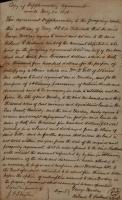 MacKay_Letter_122 An agreement that George MacKay will deed over to William M Gitt of St Louis his property in Kentucky valued at $62,500 in order to pay off his debt to Mr. Gitt. May 20, 1873. Transcription: Copy of Supplementary Agreement Made May 20, 1873 This agreement supplementary to the foregoing made this 20th day of May AD 1873. Witnesseth that the said George MacKay agrees to remit and set over to the said Hiland R Hulbrund one half the amount stipulated to be paid in the foregoing agreement to wit one half of one hundred and twenty five thousand dollars, which is sixty two thousand five hundred dollars - for the purpose of satisfying a claim which one Wm M Gitt of St Louis Mo alleges to hold against said MacKay, and for the purpose of obtaining possession of certain deeds and documents said to be necessary in order to establish and confirm the title of said Mackay to the said one hundred and thirty thousand acres of coal mineral and agricultural lands in Harlan County Kentucky and the said MacKay hereby agrees to receive and accept as payment in full for said lands the sum of sixty two thousand five hundred dollars ($62.500) provided he is released and discharged from the claim of said Gitt - and he further agrees that in case the land is not sold within one year from the date of the original and foregoing agreement, that he will refund to the said Hulburd with interest the amount expended by him in obtaining possession of the deeds and documents herein alluded to as necessary to perfect and confirm said MacKays title to the land aforesaid, estimated to be about five thousand dollars before the option of redemption reserved to said MacKay, in the forgoing agreement shall accrue and become operative Signed} George Mackay {seal} Hiland R. Hulburd {seal} Signed in presence of [signed] J. P. Stryker
MacKay_Letter_122 An agreement that George MacKay will deed over to William M Gitt of St Louis his property in Kentucky valued at $62,500 in order to pay off his debt to Mr. Gitt. May 20, 1873. Transcription: Copy of Supplementary Agreement Made May 20, 1873 This agreement supplementary to the foregoing made this 20th day of May AD 1873. Witnesseth that the said George MacKay agrees to remit and set over to the said Hiland R Hulbrund one half the amount stipulated to be paid in the foregoing agreement to wit one half of one hundred and twenty five thousand dollars, which is sixty two thousand five hundred dollars - for the purpose of satisfying a claim which one Wm M Gitt of St Louis Mo alleges to hold against said MacKay, and for the purpose of obtaining possession of certain deeds and documents said to be necessary in order to establish and confirm the title of said Mackay to the said one hundred and thirty thousand acres of coal mineral and agricultural lands in Harlan County Kentucky and the said MacKay hereby agrees to receive and accept as payment in full for said lands the sum of sixty two thousand five hundred dollars ($62.500) provided he is released and discharged from the claim of said Gitt - and he further agrees that in case the land is not sold within one year from the date of the original and foregoing agreement, that he will refund to the said Hulburd with interest the amount expended by him in obtaining possession of the deeds and documents herein alluded to as necessary to perfect and confirm said MacKays title to the land aforesaid, estimated to be about five thousand dollars before the option of redemption reserved to said MacKay, in the forgoing agreement shall accrue and become operative Signed} George Mackay {seal} Hiland R. Hulburd {seal} Signed in presence of [signed] J. P. Stryker